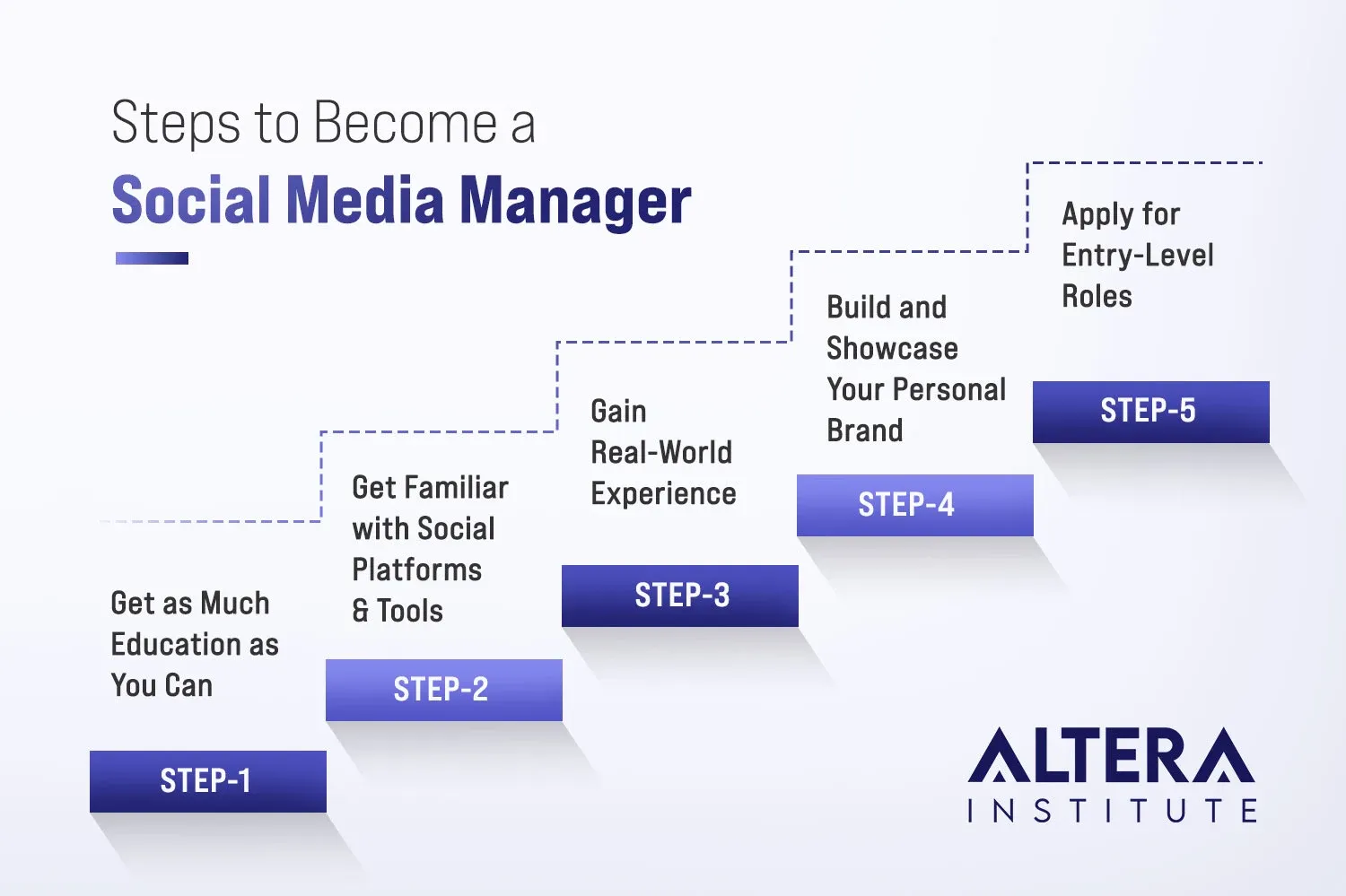How to Become a Social Media Manager?

In a world where brands live and breathe online, the role of a social media manager (SMM) has become essential. With digital landscapes evolving at lightning speed and social platforms at the center of communication, the demand for skilled professionals who can steer brand identity through tweets, reels, and viral posts is booming.
Whether you’re a digital native or someone looking to break into a creative and dynamic industry, becoming a social media manager can offer a fulfilling and flexible career path. This guide will walk you through everything you need to know—what the role entails, what skills you'll need, how to get started, and what you can expect in terms of career growth.
Who is a Social Media Manager?
A social media manager (SMM) is a digital marketing expert who handles and optimizes an organization’s online footprint across various social platforms. Their role blends content creation, audience engagement, and strategic planning to build and maintain a strong and consistent online presence. Whether it's a trending meme or a product launch, the social media manager ensures that every post aligns with the brand's voice and engages its audience effectively.
Social media managers can work in different environments: corporate settings, marketing agencies, nonprofits, or as freelancers. While the role may vary slightly depending on the industry, the core responsibility remains consistent—building and maintaining meaningful relationships between brands and their audience online.
Steps to Become a Social Media Manager
A career in social media management is perfect for you if you love creating content, analyzing trends, and connecting with people online. While a specialization in social media management can be the best path to break into this space, it is not the only route into this dynamic field. What really matters is your ability to showcase your digital skills, stay current with industry trends, and build a portfolio that demonstrates your expertise.
Here’s a step-by-step roadmap to help you become a successful social media manager:

Step 1: Get as Much Education as You Can
While a bachelor’s degree in marketing, communications, journalism, or a related field can be a solid foundation, it’s not your only option. If you’re not able to pursue a four-year degree, there are still plenty of paths available:
- An associate degree, high school diploma, or even a GED can show that you’re serious about your education.
- Supplement with certifications in digital marketing or social media strategy. Leading platforms such as HubSpot, Google, and Hootsuite provide budget-friendly or even no-cost certification courses.
- Focus your learning on core subjects like digital marketing, content creation, analytics, branding, and consumer psychology.
These programs often provide both theoretical and hands-on knowledge that’s relevant to the current industry requirements.
Step 2: Get Familiar with Social Platforms and Tools
To thrive as a social media manager, you must deeply understand how each platform functions, from audience behavior to algorithm preferences, and be confident using the tools that keep campaigns running smoothly behind the scenes. Let’s break down what that really means:
- Know Platforms Inside and Out: Each social media platform serves a different purpose, attracts a different audience, and favors different types of content. As a social media manager, you’ll need to know how to create and manage content that fits the tone, format, and expectations of each space. For example:
- Instagram – Focus on aesthetic visuals, Reels, Stories, and community interaction via DMs and comments.
- Facebook – Versatile with everything from photo posts to event promotion, and still strong for community building and advertising.
- LinkedIn – A powerhouse for professional connections, ideal for B2B networking, industry insights, and career-focused content.
- Learn to Analyze Data: Social media success isn’t only about going viral but rather about understanding why something performed well and being able to replicate that success. Every platform has built-in analytics to help you measure performance based on metrics like engagement rate, reach, impressions, click-through rate (CTR), and follower growth.
- Learn to Handle Relevant Tools: Manual posting is fine for personal accounts, but as a professional, you’ll need tools to plan, post, monitor, and analyze social media content across platforms. This is where utilizing tools like Hootsuite, Canva, Google Analytics, Adobe Express, etc., are essential and core requirements for an SMM role.
- Stay Up to Date with Trends and Algorithms: Social media is constantly evolving. What worked six months ago might not work today, as algorithms are constantly shifting, features get added, and new content styles take off overnight. Hence, make a habit of studying updates, subscribing to marketing newsletters, and engaging with marketers on LinkedIn or Twitter to learn in real-time about the latest trends.
Step 3: Gain Real-World Experience
Social media marketing requires practical experience to master and carries just as much weight—if not more—than academic qualifications. Recruiters and clients want to see proof that you can create engaging content, understand platform algorithms, manage real-time interactions, and achieve measurable results. Here's how you can build that experience from the ground up:
- Start with Internships: Internships are one of the best gateways into the professional world of social media. They allow you to apply your skills in real-time settings, learn from seasoned marketers, and get a taste of different work environments.
- Offer Your Skills as a Volunteer: Volunteer your skills to businesses and groups that need help with social media but don’t have the budget or know-how to run it effectively. These volunteer gigs can often give you creative freedom and let you experiment with strategies in a low-pressure environment—plus, you get testimonials and references.
- Freelance and Side Projects: Also consider taking on freelance gigs, even if they are short-term opportunities. Platforms like Upwork, Fiverr, and Freelancer are great for finding freelance work, and they help you develop valuable client-facing skills, like pitching ideas, writing proposals, creating contracts, and reporting on results.
Step 4: Build and Showcase Your Personal Brand
Choose a niche you’re passionate about (fashion, travel, tech, wellness, etc.) and start building a personal or themed account on Instagram, TikTok, Twitter, or YouTube. Use this experience as a case study when applying for jobs and interviews. You can literally show potential employers how you built and grew a page from scratch.
- Build a High-Impact Digital Portfolio: Your digital portfolio is the “proof of work” employers will be looking for especially if you’re just starting out. Consider it a dynamic portfolio highlighting your innovative ideas, strategic thinking, and measurable outcomes.
- Show Performance Metrics: Showcase how you have grown your page using actionable data. For example, highlight instances like “increased engagement by 35% in two weeks,” “grew followers from 500 to 2,000 in three months,” etc. This indicates that you’re not just creating content but also getting desirable results.
- Make Your Brand Work for You: Once your brand and portfolio are in place, promote it:
- Add the link to your email signature and LinkedIn profile.
- Mention it in job applications or interviews.
- Share highlights from your portfolio on your social platforms with captions that explain the value you brought to a project.
Remember, you are the product—and a strong personal brand shows that you not only understand how social media works, but also how to use it strategically.
Step 5: Apply for Entry-Level Roles
You’ve built your skills, gained real-world experience, and created a portfolio that shows you know your stuff. Now it’s time to take the leap into the professional world.
Landing your first job in social media marketing might feel intimidating, but this is where all your hard work starts to pay off. Entry-level roles are designed to help you continue learning, apply your knowledge in new ways, and grow into more senior positions.
- Target the Right Entry-Level Roles: Start by looking for positions where you can build on your foundation and get hands-on experience with day-to-day social media tasks. Common job titles to search for include social media assistant, content creator, marketing coordinator, community manager, and digital marketing assistant.
- Apply Strategically: When you’re early in your career, focus on quality instead of quantity, which includes customizing your portfolio materials to each role instead of sending the same resume to dozens of jobs. It also includes using keywords from the job description, crafting a compelling cover letter, including certifications, and showcasing your creativity rather than just technical abilities.
Becoming a social media manager doesn’t require a set-in-stone path, but it does require passion, creativity, and a commitment to learning. Whether you’re studying for a degree or self-teaching through YouTube and online courses, the most important thing is to start experimenting, creating, and connecting.
What Does a Social Media Manager Do?
Social media management goes beyond trend-chasing; it’s about crafting meaningful, impactful online experiences. It is a strategic, creative, and analytical role that helps shape how a business is seen online, which directly impacts how successful that business becomes. Let’s break it down:
More Than Just Posting Content
Creating, editing, and uploading content is just one part of the job. A social media manager must deeply understand the platforms they work with. Every platform operates differently, with unique engagement rules, audience behaviors, and content styles.
Part of the role involves planning long-term campaigns around key events, product launches, or seasonal trends. Social media managers often build detailed content calendars that align with a company’s broader marketing goals. But at the same time, they need to remain agile and ready to react to trends, conversations, or viral moments as they unfold in real time.
Voice, Visibility, and Value
Social media managers are the guardians of a brand’s online personality. They ensure consistency in tone, messaging, and visual identity across every platform. Whether they’re posting a tweet or writing a thoughtful LinkedIn article, they must always embody the values and voice of the organization they represent.
However, their job is not just about brand image; it’s also about tangible results. An effective social media plan can elevate brand visibility, funnel traffic to websites, capture leads, and drive revenue. Social media managers are often expected to track performance metrics and demonstrate how their efforts contribute to a return on investment.
Influencer Collaboration and Budget Oversight
Another major area of responsibility is influencer marketing. Social media managers identify potential influencers to partner with, negotiate collaborations, and ensure the brand is well represented through these partnerships. Whether it’s a small creator with a niche audience or a celebrity influencer with millions of followers, these relationships can significantly amplify a brand’s reach and credibility.
When it comes to paid content, they’re also responsible for managing the budget allocated to social media. That means choosing where to invest in paid advertising—whether through Facebook, Instagram, Twitter, YouTube, or Google—and making sure those investments are delivering measurable results. Effective ad spend management is a key expectation in most modern marketing departments.
A Balancing Act of Proactive and Reactive
A social media manager needs to walk the line between long-term strategy and real-time responsiveness. They are expected to engage with comments and messages, handle customer questions, and even manage negative feedback or crises with professionalism and grace. This means being proactive about building community while also being reactive enough to step in and manage public perception when needed.
No two days are the same. One day might involve crafting an elaborate launch campaign; the next might involve diffusing a PR situation or jumping on a trending topic that aligns with the brand. The landscape is constantly shifting, and social media managers need to adapt just as quickly.
Social Media Manager Skills
Success as a social media manager demands a versatile mix of creative flair, technical planning, and clear communication. Here are the top skills required:

Writing Skills
Writing is the foundation of communication across social platforms, from relevant captions to engaging stories and professional posts. Each platform demands a unique tone and structure, whether it's professional updates on LinkedIn or casual engagement on Instagram. Ultimately, a social media manager must master writing to shape their brand voice, drive interaction, and build community trust.
Research Abilities
Effective research skills are crucial in staying current in the fast-paced world of social media. With trends evolving daily, a social media manager must:
- Monitor social and digital media trends.
- Conduct competitor analysis.
- Use tools like Google Alerts, Feedly, Ahrefs, and BuzzSumo.
- Stay current on hashtags, keywords, and platform updates.
By mastering research, social media professionals can craft timely, relevant content that resonates with their audience and aligns with broader market movements.
SEO Skills
SEO knowledge enhances a social media manager’s ability to increase visibility and organic reach. Content aligned with SEO strategies can improve search rankings, drive website traffic, and connect with high-intent audiences. Managers must understand keyword research, content promotion, and the relationship between social signals and SERPs.
Creativity and Visual Design
Creativity fuels standout content that grabs attention and sparks interaction, especially on visually driven apps like Instagram and TikTok, where eye-catching graphics and videos are key.
As noted by social media consultant Alison Battisby, video editing and storytelling are among the most valuable creative skills in this field. Investing in visual storytelling allows managers to connect emotionally with audiences and elevate brand perception.
Data Analysis and Reporting
Analyzing data helps social media managers make informed decisions and refine their strategies. Through performance metrics and insights, managers can identify what content performs best, when to post, and where to allocate budget.
Analytics tools provide detailed performance reports to guide content planning and audience targeting. Data literacy ensures that social media strategies are both creative and results-driven, maximizing return on investment.
Budgeting and Resource Allocation
Managing a social media budget is a key strategic responsibility. Whether allocating funds for paid ads, content creation, or influencer partnerships, managers must ensure that spending aligns with KPIs. Strong budgeting skills allow social media managers to scale efforts effectively while maintaining cost efficiency.
Familiarity with AI Tools
AI is reshaping how social media content is created, optimized, and analyzed. Managers must understand how to use AI for personalization, content generation, customer support, and influencer targeting.
SurveyMonkey reports that nearly 88% of marketing professionals integrate AI tools into their daily workflows. Tools that streamline scheduling, image creation, and audience analysis are becoming standard. By integrating AI, social media managers can boost productivity, stay competitive, and deliver more tailored content.
Adaptability and Agility
Flexibility is essential to navigate social media’s fast-paced, ever-changing environment. New features, changing algorithms, and viral trends demand flexibility in content strategy and tone. Using A/B testing and performance analytics, managers can adjust quickly to what works and discard what doesn’t. Being adaptable guarantees a brand stays current and agile in the face of digital shifts
FAQs
Q1. What is the 5-5-5 rule on social media?
Ans: The 5-5-5 rule is a simple yet powerful method to grow your social media engagement consistently and without burnout. It works like this:
- Like 5 posts.
- Comment on 5 posts (thoughtfully—not just one-word replies).
- Spend 5 minutes doing this on each platform.
By engaging with others in a meaningful way for just 5 minutes per platform, you boost your visibility, attract new followers, and encourage reciprocal interaction. It's an efficient way to grow your audience, drive traffic, and build stronger connections—especially when applied across platforms like Instagram, Twitter, LinkedIn, TikTok, and Facebook.
Q2. What qualifications do you need for social media management?
Ans: While there’s no set path, here are common qualifications that help:
- Degree or diploma in marketing, communications, business, or a related field.
- Certifications in social media marketing (like those from Meta, HubSpot, or Digital Marketing Institute)
- Hands-on experience managing platforms like Instagram, LinkedIn, TikTok, or X.
- Skills in content creation, copywriting, data analysis, SEO, customer service, and design tools (e.g., Canva, Adobe, or video editing apps)
Ultimately, a strong portfolio and results-driven mindset matter more than formal education alone.
Q3. Is social media a good career?
Ans: Yes, social media is a rewarding and future-proof career. It offers:
- Diverse roles in strategy, content, analytics, or paid media
- Strong demand across industries as businesses prioritize online presence
- Creative freedom paired with measurable impact
- A fast-paced, evolving landscape that keeps the work dynamic and engaging
If you’re digitally savvy, adaptable, and enjoy connecting with audiences, social media is a great career path.
Q4. How to become a social media manager with no experience?
Ans: Start by managing your own social accounts or volunteering for small businesses or nonprofits. Build a portfolio showcasing your work, complete free or low-cost certifications (e.g., HubSpot, Meta), and stay current with trends and tools.
Q5. How to become a social media manager without a degree?
Ans: Focus on learning through online courses, certifications, and hands-on practice. Create a strong personal brand and portfolio that highlights your skills, results, and understanding of social media strategy.
Q6. How to become a freelance social media manager
Ans: Build your own brand and portfolio, create profiles on freelance platforms like Upwork or Fiverr, and start pitching services to small businesses. Offer value-driven packages and use testimonials to build credibility and grow your client base.
Summing Up
Becoming a social media manager is more than just mastering platforms—it’s about understanding people, strategy, and storytelling in the digital age. Whether you’re just starting out or looking to transition into a more creative, flexible career, this field offers a wealth of opportunities to grow, make an impact, and stay ahead in a fast-moving industry.
With the right mix of education, hands-on experience, and a strong personal brand, you can carve out a fulfilling career that blends creativity with analytics and communication with community building. So, start exploring, stay curious, and let your digital voice lead the way—because the brands of tomorrow need the social storytellers of today.

